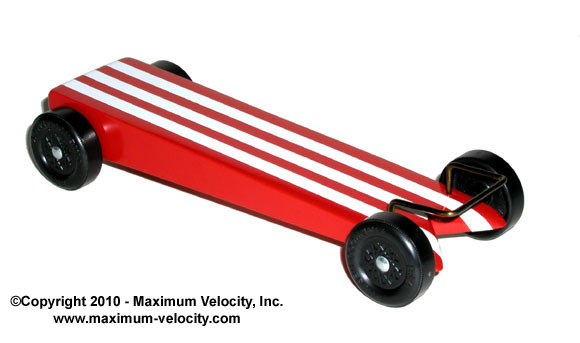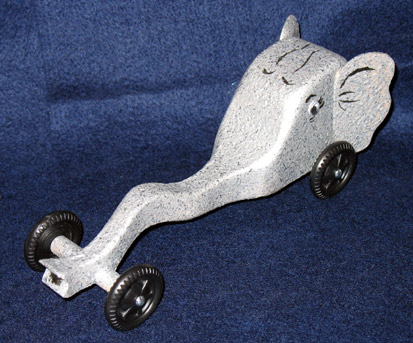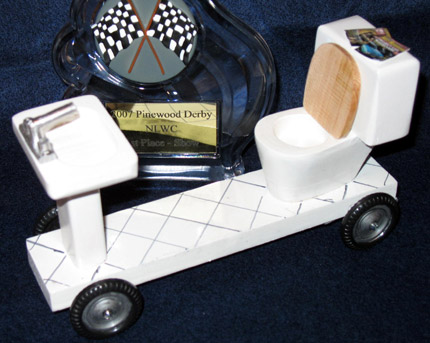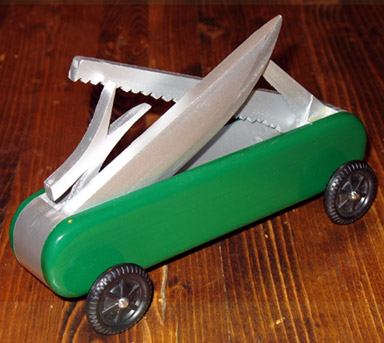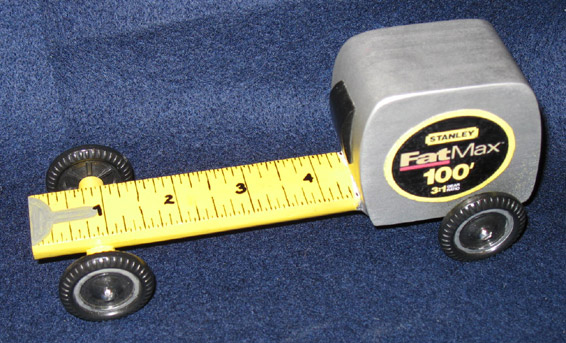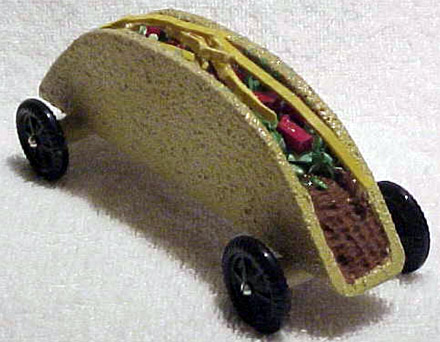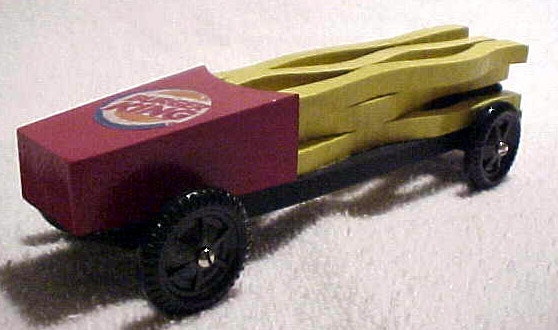– Feature Article – Is Your Finish Line Providing Accurate Results?
– Pinewood Derby Car Showcase
– Memory – Mikey at the Lube
Is Your Finish Line Providing Accurate Results?
(Throughout this article I have identified action items that track owners should take to make sure that the finish line provides accurate results.)
During our April race, a parent caught my attention and stated that the electronic finish line was not accurately identifying the finish order. I carefully watched the next several races, and did detect a discrepancy. Was the finish line malfunctioning? Read on to find out!
Finish Line Principle
Electronic finish lines use optical sensors1 to determine when a car crosses the finish line. However, there is one fundamental principle of finish lines that must be understood;
- Electronic Finish lines select the finish order based on the sequence in which the light sensors are activated, not necessarily on the order in which the cars cross the finish line.
To better explain how this is true, we must consider sensor, car, and track characteristics which would cause the finish line to record a finish order which is not the same order that the cars crossed the finish line.
Sensors
Characteristics
Optical sensors2 trip when the amount of light entering the sensor drops below a certain threshold. This light blockage (caused by the car passing between the sensor and light source) is known as ‘occlusion’ (see Figure 1). The amount of occlusion required varies by manufacturer and from sensor to sensor. Manufacturers of finish lines generally test the sensors to make sure that the amount of occlusion required to trip the sensor is consistent within the finish line unit. If the sensors are not consistent, then the finish line results will be less than accurate (i.e., a sensor with a lower occlusion percentage will trip earlier, giving an advantage to the lane on which it is mounted).
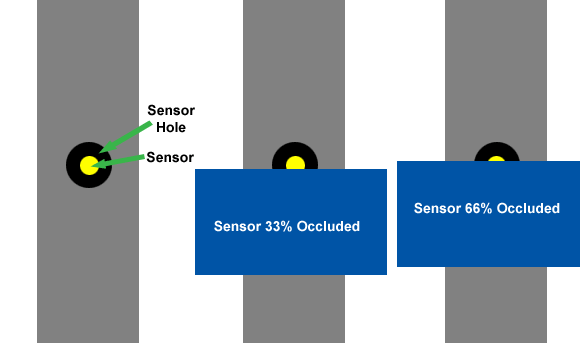
I tested the occlusion of two electronic finish lines from two major manufacturers. On one, the amount of occlusion required was about thirty-three percent, while the other was about sixty-six percent. Fortunately, in both cases the occlusion percentage was consistent within the unit.
- Action 1: Check the occlusion percentage for your sensors to make sure they are consistent.
Placement
In order for a finish line to accurately judge a race, the sensor holes must be drilled in a straight line, perpendicular to the track. In addition, the sensors must be mounted accurately in the hole. Generally, the sensor is smaller than the hole in the track. For accurate results, the sensor must be centered in the track hole.
- Action 2: Verify sensor alignment and placement.
Lighting
Most sensors are infrared (IR) sensitive, and are generally not affected by room lighting or camera flashes.3 However, reflective surfaces on the track and car can change the amount of IR entering the sensor. This can be limited by painting a non-reflective black stripe across the finish line area.4 Light variance can further be controlled by reducing the diameter of the sensor hole. This can be accomplished by inserting a bushing with a small aperture, sized to fit the hole. (see Figure 2)
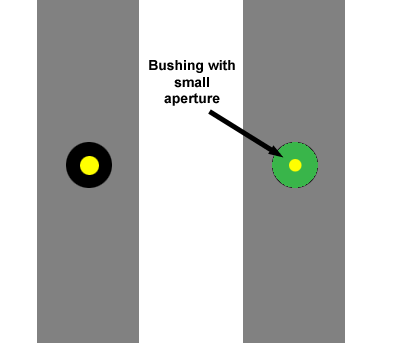
- Action 3: Reduce reflection with black, non-reflective paint, and reduced apertures.
Track Characteristics
Most tracks use a raised center guide strip to hold the car on the track. The width of the guide strip, determines the amount of deviation from the center line that the car is allowed to travel.
The typical guide strip width used today is 1-5/8 inches (see Figure 3). This width effectively limits the side to side travel of the car.
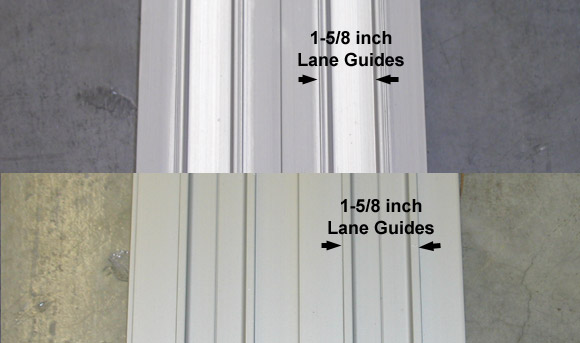
However, some tracks have a lane guide strip of 1-3/8 inches. Figure 4 shows a photo of a homemade track that was based on plans provided by Awana. Some plans on the Internet also call for a 1-3/8 inches lane guide strip.
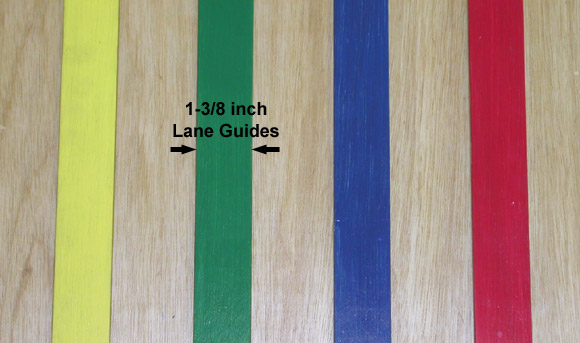
Narrower lane guides allow the car to deviate a greater distance from center-line.5 For a car with a full-width (or reasonably wide) front end this deviation causes no issues at the finish line. However, cars with narrow noses can have problems with narrower guide strips.
Consider a car with a 1/2 inch wide nose crossing the finish line on a track with 1-3/8 lane guides. The finish line sensors require a 66 percent occlusion. If the car is positioned at the center of the track when the finish line is crossed, then the finish will be properly registered. However, if the car is riding the rail, then the car may not register properly. In Figure 5, the car has crossed the finish line, but the sensor has not tripped (not 66 percent occluded). This car will need to proceed nearly 1-1/2 inches past the finish line before the sensor trips. Figure 6 shows a finish between this car and a car with a wider nose.
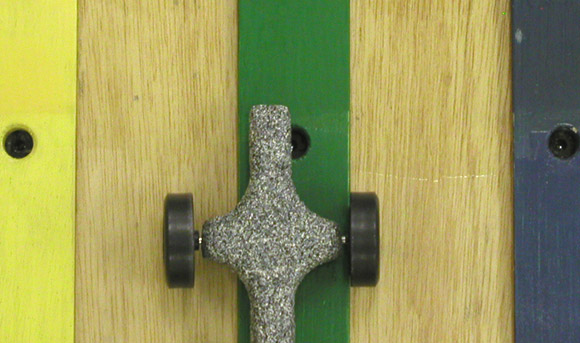
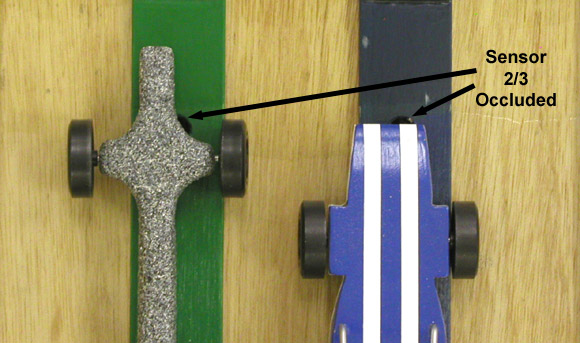
In this case, the narrow lane guide, the narrow nose on the car, and the 66 percent occlusion requirement add together to create a major discrepancy. But note that narrow nose cars can cause discrepancies under less severe circumstances. When the two cars in Figure 6 were tested on a track with a lane guide measuring 1-5/8 inches, and a sensor requiring a 33 percent occlusion, the narrow nose car still had a 1/4 inch disadvantage when it rode the rail.6
If alerted to the narrow nose issue, entrants can choose to either design the car with a wider nose, or install a nose wing on the car.
- Action 4: Test your track for discrepancies when using narrow-nosed cars. If a discrepancy exists, insert a note into race rules and handouts alerting the builder of the issue.
Car Characteristics
In addition to a narrow nose, other car characteristics can result in finish line discrepancies. These include:
- Reflective surface on the underside of the car (delays sensor trip due to reflective light).
- High-nose on the car (allows more reflective light, possibly delaying the sensor trip).
- Narrow ‘Cheater Bar’ on the front of the car (not enough material to occlude the sensor) – See Figure 7.
Figure 7 – Spoiler May Not Trip Sensor
- Action 5: Alert builders of any car characteristics which can result in finish line discrepancies.
Conclusion
After discovering these issues with our track I painted a flat black stripe across the finish line and inserted bushings with narrow apertures into the sensor holes (see Figure 8). This has eliminated light reflection issues.

In addition, I plan to put an alert in the race rules regarding narrow-nose cars; I will recommend a minimum of a 3/4 inch wide front end for accurate judging. Furthermore, when our group chooses to invest in a new track, we will choose a track with wider lane guides, and preferably, an electronic finish line with a lower sensor occlusion requirement.
If you are a race leader, then I encourage you to test your equipment and take the necessary actions to ensure a fair race. If you are competing, then consider using a car with a wider nose and painting the bottom of the car flat black.
1With one known exception: the Supertimer uses physical switches to determine the finish order.
2For more information on sensor occlusion and timer accuracy, please refer to Volume 5, Issue 11, “Pinewood Derby Timer Considerations“.
3Infrared sensors are not intended for outdoor use, as the sun produces high levels of infrared light which can affect the sensors. A sunlight option is available on the “Judge” timer at: www.newdirections.ws
4Entrants can also reduce this issue by painting the bottom of the car flat black. I used Krylon-brand “Ultra-flat Black” with success.
5The amount of wheel hub to car body gap also affects the amount of deviation. I am assuming a normal gap of 0.035 inch.
6Generally, a car nose width of 3/4 inch is sufficient for tracks with a 1-5/8 inch lane guide.
Pinewood Derby Car Showcase
Although this is a break from the “norm”, today I am including six photos sent to me by Wade Charlesworth. I know that you will agree that these are very unique cars. Here are excerpts from the note I received from Wade:
“Thank you for the interest in the cars I have made. Every year we try to have a theme so that we don’t end up with the same cars repainted and the same individuals winning over and over. The cars must be retired after the season. This year’s theme was anything in your house. It was a fantastic turn out. If you look around your house you will find an amazing amount of ideas for cars. The elephant, bathroom, tape measure, and knife were from this year (no, there wasn’t an elephant in the house; it was modeled after a statuette).
Last year’s theme was anything to do with food, hence the taco and french fries. We also had a butter tray, a Butterfingers candy bar with a bite out of it, a pumpkin pie, a Snickers bar, celery with peanut butter, and a Smore’s car. Please use whatever you feel is appropriate; I just want kids to know that you can make any kind of car you want if you put your mind to it.”
Elephant
Bathroom
Swiss Army Knife
Tape Measure
Taco
French Fries
Pinewood Derby Memory
Mikey at the Lube
It looked extremely rocky for Mike’s pinewood car that day.
The car did not look speedy as it ran its opening race.
And as Mike sat and sadly watched his car lose in a rout,
A pallor wreathed the features of this young and trusty scout.
His folks almost got up to go, they’d given up all hope.
“But no,” they thought, “We can’t quit now. Our son is not a dope.”
They thought if only Mike would think to lubricate his wheels…
They’d put up even money, then, that he could beat the field.
But Mikey’s Dad, you see, his brain was often on vacation.
He’d neglected to discuss with Mike the need for lubrication.
So for Mike’s parents hope of pinewood glory seemed afar,
For there was little chance of Mikey lubing up his car.
When suddenly young Mikey sprinted fast along the floor.
He crashed into the donut stand, he bounced into a door.
He caromed toward a window, and rebounded across the room.
And now Mikey, clever Mikey, was advancing toward the “lube”.
There was ease in Mikey’s manner as he lubed his car with grace,
There was pride in Mikey’s bearing, a smile on Mikey’s face.
And as he took his dirty hands and wiped them on his pants,
Dad said to Mom, “Can you clean those?” And Mom replied, “Fat chance!”
Then from Mike’s gladdened parents, there went up a joyous cheer.
It rattled off the ceiling, it echoed far and near.
It rumbled through the spectators, annoying half the place,
For Mikey, and his pinewood car, were getting set to race.
Two hundred eyes were on him as he staged his car on the track.
One hundred voices giggled as he tripped when he stepped back.
And as the official starter set the starting line to trip,
Defiance glanced in Mikey’s eye, a sneer curled Mikey’s lip.
Now down the pinewood derby track the cars unheeded sped.
Mike’s parents shouted loudly as their son’s car forged ahead.
And when the dust had lifted at the finish of the heat,
Mike raised his fists in triumph as his car won by two feet!
Thrice more Mike’s car ran down the track, thrice more it led the way.
The crowd was now behind him, they thought he would win the day.
And when the heats were over and they totaled up the score.
Well, Mike was first, but he was tied with some kid from Den Four.
The Committee quickly huddled, they weren’t sure of what to do.
‘Til a Tiger Cub said, “Race ’em off! Just use lanes one and two!”
And so they raced, and Mike’s car sped to victory, like a dart,
But it wouldn’t count this time because the judges yelled, “False start!”
From the benches, black with people, there arose an awful din,
Like the snoring of a Webelos fast asleep inside his tent.
“Egg them! Egg the judges!”, shouted someone in the stands,
And its likely they’d have egged them had not Mikey raised his hand.
With a smile of Scouting charity, young Mikey’s visage shown.
He stilled the rising tumult, he bade the race go on.
He signaled to the starter, he staged his car again,
The crowd knew now that Mikey would not be denied this win.
The sneer is gone from Mikey’s lip, there’s fire in his belly,
Probably from pastrami he ate earlier at the deli.
And now the starter trips the gate, and now the cars go by,
And now the air is shattered as they cross the finish line.
Oh, somewhere in this favored land, the sun is shining bright.
The band is playing somewhere, and somewhere hearts are light.
But Mike, alas, has suffered the most shameful of disgraces,
His car has been disqualified! You have to lube BEFORE the races!
Copyright ©1997-1998 by Cory Young. All rights reserved.
Reprinted by permission
Q&A
Some questions about Awana wheels and axles:
What is your experience with Awana wheels?
Awana wheels are generally quite round, but they do have nasty molding spikes. So you will need to remove the spikes, then mount the wheel on a mandrel and polish the tread surface and inside edge with fine grit (600 grit or finer) sandpaper. Make sure to keep the sandpaper wet; the plastic is soft and can melt. For this reason, avoid using a high-speed Dremel-type tool. Instead use a hand drill on medium speed.
Are the axles polished when we get them in the kit, or do they need to be polished with your Axle Polishing Kit?
Awana axles should be polished. You can use the Axle Polishing Kit, however some polish will work as well. I suggest either Brasso (a household brass polish) or Mother’s Chrome Polish (auto parts store). Place the axle in the chuck of a drill, apply a dab of polish to a soft rag, polish for about 10 seconds, and then buff off the residue with a clean part of the rag.
Do you make a Pro-Axle Press II for Awana axles? The “Note” under that section says the Pro-Axle Press II is not for Awana axles.
Unlike nail axles, Awana axles are generally straight so an axle press is not normally needed. If you do find a bent Awana axle you can use the press to straighten it, or you can just replace the axle.
Want Answers?
Do you have a pinewood derby-related question? If so, e-mail us your question.We answer all questions by e-mail, but not every question will appear in the Q&A section of the newsletter.
Back Issues
Are you a new subscriber, or have you missed some of the previous newsletters? Don’t miss out; all of the issues for Volume 5 through Volume 17 are posted on our web site.
Newsletter Contributions
We welcome your contributions. If you would like to contribute an article, a web site review, a speed tip, or a pinewood derby memory, please e-mail us.
Subscription Information
The Pinewood Derby Times is a free e-newsletter focused on pinewood derby racing. It is published biweekly from October through March.
If you haven’t already done so, please forward this issue to your pinewood derby friends. But please don’t subscribe your friends. Let them decide for themselves. Thanks.
If this newsletter was forwarded to you, why not subscribe to receive this newsletter. There is no cost, and your e-mail address is safe, as we never sell or share our distribution list.
To subscribe, send a blank e-mail to
pi*********************@*******st.com
You will receive a confirmation e-mail. Reply to the confirmation e-mail and you will start receiving the Pinewood Derby Times with the next issue.
Randy Davis, Editor, Pinewood Derby Times
E-Mail: in**@**************ty.com
(C)2018, Maximum Velocity, Inc. All rights reserved. Please do not reprint or place this newsletter on your web site without explicit permission. However, if you like this newsletter we grant permission, and encourage you to e-mail it to a friend.
Maximum Velocity disclaims any personal loss or liability caused by utilization of any information presented in this newsletter.
The Pinewood Derby Times is not specific to, and is not affiliated with the Boy Scouts of America, YMCA, Awana, or any other organization.
(R)Maximum Velocity is a registered trademark of Maximum Velocity, Inc.
(R)Pinewood Derby is a registered trademarks of the Boys Scouts of America.
(R)Awana is a registered trademark of Awana Clubs International.
All other names are trademarks of their respective owners.

